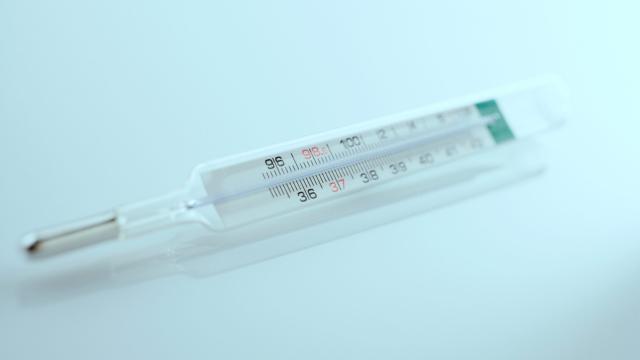Photo via Getty Images
Earlier this year, I took my 14-month-old son Ezra to the local urgent care clinic, where I got confirmation of an ear infection. It made sense, based on his fever, but as we drove home, I thought he seemed … disoriented. I tried to shake it off — I was still a new mum, probably overreacting.
I laid Ezra down for a nap after we got home, and started catching up on work emails at the kitchen table. When he woke up, he seemed less cranky than before, though still hot to the touch. We cuddled up on the couch with a snack and a movie. Maybe five minutes later, I felt him jolt, the kind of startled movement that happens when you’re on the very edge of sleep.
Then it happened again. And again. And again.
Confused, I pulled him off my lap to peer at his face — and a current of fear and panic raced through me. He was convulsing steadily with an ashen colour, glazed-over eyes and a contorted body. I stood up, carefully cradling his tiny body in my arms, and called 911. I had never seen a seizure in real life, especially not happening to a little kid. Especially not my baby.
I went into full parental panic mode, where you’re acting like you’ve got it under control on the outside but completely falling apart on the inside. The paramedics came shortly after, and while the ambulance ride was a blur, his care team at the children’s hospital assured me he’d be fine. It was a febrile seizure — a seizure associated with a spike in body temperature — relatively harmless, even though those were the most frightening few minutes of my life.
Two to five per cent of American children will experience a febrile seizure before the age of five. Here’s what all parents need to know about them.
They’re Caused by High Fevers
According to Dr. Ashanti W. Woods, a pediatrician at Mercy Medical Center in Baltimore, febrile seizures are triggered by fevers of 100.4 (38C) or greater, especially when there is a quick upward spike.
Symptoms and Timing Vary, But They Mostly Impact Toddlers
Most febrile seizures are characterised by twitching, convulsions, eye rolling, stiffening and a loss of consciousness. Other symptoms to look for are general unresponsiveness, urination, vomiting and lethargy. Those lasting longer than 15 minutes, or when only one side of the body is impacted, are called complex febrile seizures.
Young children between the ages of six months and six years are most susceptible, and length of a seizure varies. “These episodes usually last seconds, but sometimes up to 2 or 3 minutes,” says Dr. Jarret Patton, a pediatrician in Pennsylvania. “They typically happen in a child less than the age of 6 years and over the age of 6 months, but the average age is around 18 months.”
If It Happens Once, It May Happen Again
One of the most frustrating elements of febrile seizures? A third of children who have them will have another, and there’s not much you can do about it as a parent. Also, age matters: The younger the child, the higher their chances of having another seizure just like it.
Your Kid Is (Very Likely) Going to Be OK
“As scary as these are for parents, most are harmless and resolve without treatment,” notes Dr. Alison Mitzner, a pediatrician in New York. “Your pediatrician may discuss anti-fever medications, such as Tylenol or Motrin, and depending on your child’s age or number of febrile seizures, additional treatments could be added.”
Treatment is generally rooted in observation, and aimed at finding and treating the source of the fever, which is often a viral illness. “If your child has a febrile seizure, it is likely that they may never have another seizure again,” says Dr. Patton. “It does not mean that they will go on to develop epilepsy. However, if they have a few seizures when febrile, it may indicate an underlying seizure disorder.”
Here’s What to Do During a Febrile Seizure:
- Stay as calm as possible.
- Remove any present dangers, like falling objects, unsteady surfaces, blankets or choking hazards.
- Put your child in a safe position with no restraints, such as rolled to one side of the body on a flat, firm surface. Don’t worry about trying to “cool down” your child, as it won’t necessarily impact the fever. Focus on safety first and allow the seizure to run its course.
- Note what time the seizure starts and stops. For any seizure under 3 minutes, make sure your child is seen by a physician that same day. If the seizure lasts longer than 5 minutes, call 000 immediately.
- Pay attention to details: did he or she lose consciousness? Throw up? Make noise? Describing the seizure is the most helpful thing you can do to help your doctor make the correct diagnosis.
After a febrile seizure, most kids are sleepy and low-energy, but will return to normal activity and energy levels within a day or two. Even though you may worry every time your child’s temperature rises, you’ll at least be equipped to handle a febrile seizure if it happens — and you can rest assured he or she will be just fine.

Comments